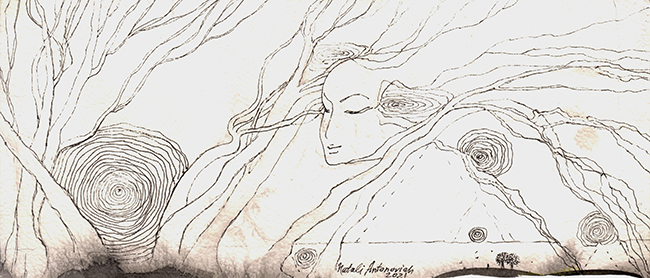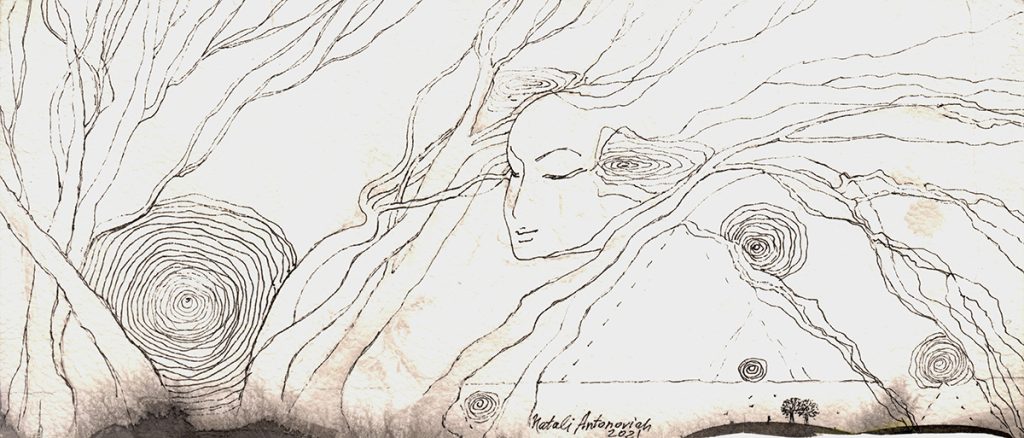Natali Antonovich, an artist whose work acts as a portal into her inner world, ponders the difficulty of self-expression. Her art is not about polished declarations but about the fragile in-between states where thought, memory, and observation intersect. She has always been a perceptive observer, paying close attention to the overlooked details that others might dismiss. This habit of careful watching and reflecting has followed her throughout her life, shaping her approach to both art and living. Antonovich’s pursuit of individualism is not loud or declarative; it is subtle, persistent, and deeply personal. Through her practice, she draws viewers into an atmosphere where ordinary materials and fleeting imagery become carriers of profound questions. Her work is less about providing answers and more about opening spaces where ambiguity can be embraced.

Impermanence
Created in 2021, Impermanence is a small work on paper using only ink. It is simple in its construction, yet layered in meaning. The piece is paired with a poem written by her daughter, Natalya Hrebionka. The collaboration itself adds an intimate quality: a dialogue between generations, between image and text. It is not just an illustration but a conversation about fragility, change, and the impossibility of permanence.
The poem begins with thin branches erasing stars from the sky. It is an image of nature’s hand sweeping away what feels eternal. Stars, often seen as fixed and unchanging, are here momentary, vulnerable to a passing gesture. The choice of branches emphasizes delicacy. They are not machines or sharp instruments but fragile twigs, able to undo what we think of as immovable. The work echoes this sense visually—lines crossing and weaving, forming a kind of net that both contains and dissolves.
As the poem continues, wind reenters. Strong and unpredictable, it signals change that arrives without asking. Shadows “go blind,” caught at a crossroads. In Antonovich’s drawing, one might imagine these crossroads as intersections of ink, where lines tangle into spider-like webs. The imagery is not decorative; it is restless. She brings forward the tension between order and collapse, between pattern and disarray.
Knots then appear, tying space itself. Thoughts become sleepless, restless, circling back on themselves. In both the poetry and the artwork, there is no smooth resolution. Instead, the viewer is invited into a landscape where stability is elusive. The poem concludes with life compared to monsoons—sudden, overwhelming, destructive, and yet part of natural cycles. Antonovich’s ink strokes mirror this volatility, their delicacy suggesting that even strong gestures can fray and dissolve.
What makes Impermanence compelling is how it resists finality. The artwork does not declare a single interpretation. Instead, it holds the viewer inside a moment of flux. The combination of poetry and drawing emphasizes how language and image can meet without fully merging. The words gesture toward experiences of instability, while the drawing offers a visual equivalent that refuses to settle.
Antonovich’s choice of miniature scale is also telling. Rather than monumentalizing impermanence, she presents it as something to be held closely, studied quietly, almost like a secret. Smallness makes the piece intimate, demanding attention rather than spectacle. It suggests that the great truths about instability are not always found in grand gestures but in fine lines, quiet spaces, and fleeting images.
The collaboration with her daughter adds another layer of meaning. It brings impermanence into the realm of family, memory, and generational dialogue. The artwork becomes both personal and universal: a reflection on change, but also a record of two voices—mother and daughter—meeting through art. In this way, Impermanence is not just about loss or transience; it is also about continuity, about the act of sharing.
Ultimately, Antonovich reminds us that impermanence is not an abstract idea but a lived experience. Stars fade, winds shift, shadows falter, and thoughts refuse rest. In turning these sensations into art, she gives form to the unease of instability while also acknowledging its inevitability. The work does not soothe; it accepts. Viewers may leave with more questions than answers, but that is precisely the strength of her art. It lingers not because it resolves uncertainty, but because it keeps it alive.

